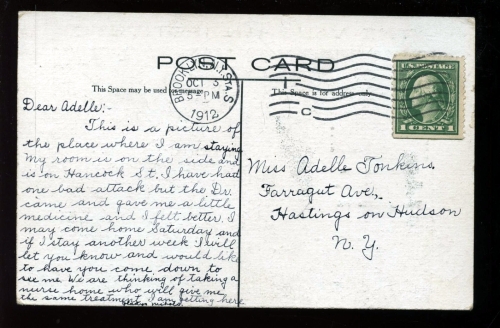Past and Present: The Vaughan Institute
A look at Brooklyn, then and now. I regularly search eBay for postcards and photographs of historic Brooklyn for use in my columns, especially this one. Usually, I see the same postcards over and over again, but every once in a while a new one shows up, revealing a slice of old Brooklyn that is…

A look at Brooklyn, then and now.
I regularly search eBay for postcards and photographs of historic Brooklyn for use in my columns, especially this one. Usually, I see the same postcards over and over again, but every once in a while a new one shows up, revealing a slice of old Brooklyn that is usually lost and long forgotten. The Vaughan Institute card is this week’s forgotten look into the past.
Brooklyn was home to many medical institutions, ranging from hospitals to private sanitariums and specialized clinics. Like today, medical treatment ranged from the latest in traditional modern medicine to homeopathic cures on down to pure quackery. There has long been something for everyone here. A bit of research shows that the Vaughan Institute was founded for the treatment of rheumatic disorders. Today’s doctors don’t use the word “rheumatism” much anymore, but it is a catch-all name for medical problems in the connective tissues and joints. Rheumatic fever still remains in the lexicon, but arthritis, fibromyalgia, chronic back pain and other ailments are much more familiar names to us now.
The Institute was founded by its namesake, Dr. John Aubrey Vaughan, a prominent Brooklyn doctor. Dr. Vaughan had been born in Nova Scotia, and came to the States at the age of 35 to study medicine and surgery at Long Island College Hospital and at Bellevue. His practice in general medicine soon led to a specialty in rheumatism, and he opened the Institute in 1904 with the financial backing of wealthy investors.
The Institute first opened here at 1223 Bushwick Avenue, in an old mansion that sat on the corner of Hancock Street. As we can see in the photograph, there wasn’t much around the grounds, even in 1904, and the Institute offered patients a large groomed lawn, and what looks like a peaceful suburban setting in which to get well. The card advertises that the Institute treated “rheumatism in its various forms, neuritis, spinal and nervous afflictions.” Their treatments included massage, physical therapy, vibration therapy, drugs and diet. They specifically did not treat mental patients. You couldn’t say that today.
The postcard itself was sent by a female patient at the Institute named Gladys Nichols to a friend in Hastings on Hudson. Miss Nichols writes: “This is a picture of the place where I am staying. My room is on the side, and is on Hancock Street. I have had one bad attack, but the Dr. came and gave me a little medicine and I felt better. I may come home Saturday, and if I stay another week I will let you know and would like to have you come down to see me. We are thinking of taking a nurse home who will give me the same treatment I am receiving here.”
The Institute wanted to expand, and somewhere around 1910 bought undeveloped property at 1040 Park Place, across from Bedford (now Brower) Park, in the St. Marks District. A large building was erected and then another building was built behind it, joined by a courtyard. Both buildings could house a total of forty patients. The next door neighbor sued the Institute on the grounds that it was running a business on a block that had a covenant for private houses only. The case ended up in the Court of Appeals, where the judges ruled that the covenant had not been broken, as the quiet enjoyment of the neighbors was not marred by the Institute, and that the houses, from the street, did not look like businesses.
Not that it really would matter all that much. Two years later, in 1914, Dr. Vaughan had a stroke, and never really recovered, contracting a debilitating kidney ailment on top of that, which forced him to retire. He had run the Institute with his son, Dr. Ernest M. Vaughan, but the board of directors decided to close it all down, and the Vaughan Institute shut its doors that year. In 1916, Dr. Vaughan died of kidney disease, at the age of 71. The Vaughan Institute now only exists in this old postcard.
Today, the house in Bushwick is long gone, replaced by an apartment building that was built in 1915. Many of Bushwick Avenue’s old mansions were being replaced by large six story apartment buildings at this time. This one was designed by R. Thomas Short, for developer Chauncey Cozine, who built enough buildings in the area to warrant his own historic district. Both names are familiar to those who follow Bedford Stuyvesant’s development as well. Short designed the Kismet Temple for the Shriners, and Cozine was responsible for elegant apartment buildings on MacDonough Street. The property on Park Place is also now an elegant six story apartment building. GMAP








What's Your Take? Leave a Comment